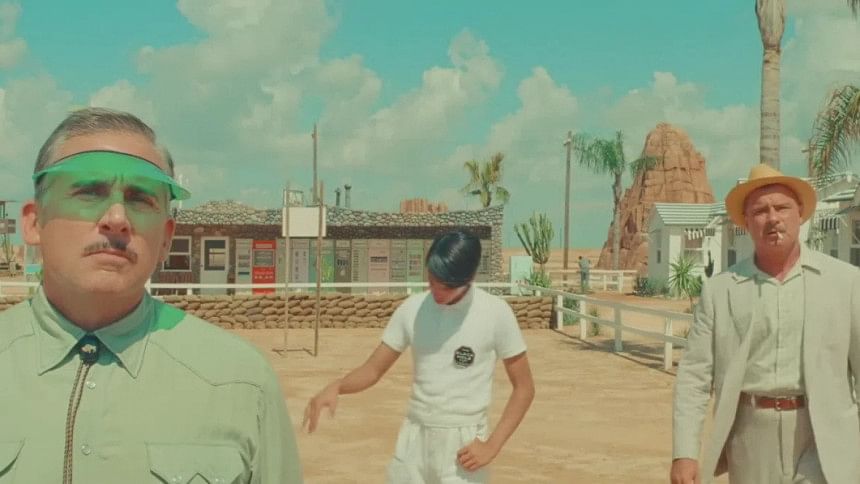Asteroid City: Wes Anderson’s quirky extra-terrestrial delight

Wes Anderson's "Asteroid City" is a visually imaginative and whimsically oddball space adventure that takes the audience on an eccentric journey through the cosmos. As expected from the renowned director, the film is a visual feast, with every frame carefully composed and bursting with Anderson's trademark attention to detail. With his signature blend of whimsy and melancholy, Anderson takes us on a journey through a world that feels both familiar and otherworldly.
The film opens with war photographer Augie Steenbeck, played by the talented Jason Schwartzman, arriving at Asteroid City and encountering the town's eccentric mechanic, portrayed by the illustrious Matt Dillon. What starts as a seemingly simple car breakdown evolves into a metaphor for the unpredictability of life. Anderson sets the stage for the themes that will reverberate throughout the film—uncertainty and the uncontrollable chaos that life often throws our way.
As the story unfolds, we are introduced to an eclectic group of characters who converge upon "Asteroid City" for a youth astronomy convention. Their lives intersect in a delightful array of subplots that explore loneliness, emotional repression, and the human desire for order in a world filled with uncertainties. The addition of an unexpected alien encounter further amplifies the film's existential undertones.

"Asteroid City" presents a complex narrative structure, akin to a television show about the making of a play, which adds layers of abstraction to the storytelling. While it may draw comparisons to "The Grand Budapest Hotel", which is a story within a story within a story, Anderson digs deeper into this approach, emphasising the frequent interjections that shift us from one layer to the next.
These deliberate choices highlight Anderson's purposeful creation of distance in his storytelling, which serves to intertwine the elements of the story seamlessly. This unique approach allows Anderson to explore the interplay between reality and art, providing the audience with glimpses into the struggles faced by the characters both on and off-screen.
As the layers of the narrative unfold, we find ourselves contemplating the fine line between performance and authenticity, a theme that resonates deeply with Anderson's own filmmaking process. The film's thoughtful execution and poignant exploration of tormented reflections at its core reveal Anderson's mastery in expressing profound emotions through his distinctive storytelling style.

The film's ensemble cast delivers exceptional performances, with Schwartzman's portrayal of Augie Steenbeck as a standout. Augie's emotional constipation and stoicism provide a poignant and relatable portrayal of the human struggle to come to terms with loss and grief. Through Augie's lens as a war photographer, Anderson skilfully explores the act of preserving emotions through art, often keeping them at a safe distance. It is a portrayal that lingers long after the credits roll, leaving the audience contemplating the complexities of human emotion.
Scarlett Johansson shines as Midge Campbell, a movie star who becomes a beacon of hope for Augie amidst his emotional turmoil. Additionally, the supporting cast, including Steve Carell, Tom Hanks, Adrien Brody, Edward Norton, Margot Robbie, Tilda Swinton, Bryan Cranston, and Rupert Friend, contribute to the film's rich tapestry of characters, each wrestling with their own existential dilemmas.
At its core, "Asteroid City" is a meditation on uncertainty and the ever-changing nature of life. The film's clever use of interjections and meta-narrative elements serves as a reflection of how we grapple with the unpredictability of existence. Anderson's ability to weave together humour and melancholy in a seamless manner adds depth to the narrative, making the emotional journey all the more captivating.
Visually, "Asteroid City" is a masterclass in art direction and production design. Anderson's meticulous attention to detail creates a captivating world that draws the audience into its charm and quirkiness.
One cannot help but be captivated by the film's enchanting soundtrack, composed by frequent Anderson collaborator Alexandre Desplat. The music perfectly complements the offbeat atmosphere of "Asteroid City", adding another layer of charm to the overall cinematic experience. From whimsical melodies to emotionally stirring orchestral arrangements, the soundtrack enhances the film's emotional depth and serves as a companion to the characters' journeys.
Anderson's meticulous attention to detail extends beyond the visual and auditory realms. The script is replete with witty dialogue and clever wordplay, often infused with Anderson's trademark dry humour. The film's pacing strikes a perfect balance, allowing for moments of introspection, humour, and heartfelt emotion to seamlessly coexist, all while maintaining Anderson's distinct directorial voice.
While some may view Anderson's style as merely "twee" or surface-level, "Asteroid City" demonstrates that his whimsy is a vehicle for deep introspection. For instance, a recurring motif of a tiny mechanical cog becomes a symbol of interconnectedness, reminding us that even the tiniest actions can have far-reaching consequences.
"Asteroid City" stands as a testament to Wes Anderson's unparalleled ability to transport audiences to imaginative and idiosyncratic worlds. The film is a captivating exploration of human existence, loneliness, and the pursuit of meaning in a chaotic world. Wes Anderson's masterful storytelling, combined with stellar performances and impeccable art direction, elevates the film to a cinematic gem.

 For all latest news, follow The Daily Star's Google News channel.
For all latest news, follow The Daily Star's Google News channel. 








Comments